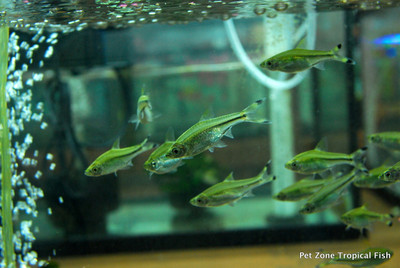Scissortail Rasbora
Posted by Max Gandara on on 2nd Apr 2025
Scissortail Rasbora: A Vibrant Addition to Your Aquarium
The Scissortail Rasbora, scientifically known as Rasbora trilineata, is a popular freshwater fish among aquarium enthusiasts. Known for their striking appearance and peaceful nature, these fish make an excellent addition to a community tank. Let’s dive into the details of caring for and understanding these fascinating creatures.
Appearance and Behavior
The Scissortail Rasbora is named after its distinctive tail, which resembles a pair of scissors. This visual feature is complemented by its sleek, elongated body and a shimmering silver color that catches light beautifully. A prominent black line runs along its body, adding to its visual appeal.
These fish are known for their active swimming behavior, often darting around the tank with grace. They are social creatures that thrive in schools, so it's recommended to keep them in groups of six or more. This schooling behavior not only enhances their well-being but also creates a dynamic and lively display in your aquarium.
Natural Habitat
Originating from Southeast Asia, particularly in countries like Thailand, Malaysia, and Indonesia, Scissortail Rasboras inhabit clear, fast-flowing streams and rivers. Their natural environment is rich with vegetation, offering them plenty of cover and a diverse diet.
Tank Setup and Care
Tank Size and Environment
To replicate their natural habitat, a spacious tank of at least 20 gallons is ideal. This allows ample room for schooling and swimming. Ensure the tank is well-planted with live plants, which provide hiding spots and contribute to water quality. The addition of driftwood and rocks can further mimic their natural surroundings.
Water Conditions
Scissortail Rasboras prefer slightly acidic to neutral water, with a pH range of 6.0 to 7.5. Maintaining a temperature between 72°F and 79°F (22°C to 26°C) is optimal for their health and vitality. Regular water changes and a reliable filtration system are essential to keep the water clean and free from toxins.
Diet
In the wild, Scissortail Rasboras are omnivorous, feeding on insects, larvae, and plant matter. In captivity, they thrive on a varied diet that includes high-quality flake or pellet food, supplemented with live or frozen foods such as brine shrimp and daphnia. Feeding them a diverse diet ensures they receive all the necessary nutrients.
Compatibility with Other Fish
One of the highlights of Scissortail Rasboras is their peaceful temperament, making them compatible with a variety of tank mates. They coexist well with other similarly sized and non-aggressive fish, such as Tetras, Guppies, and Corydoras. Always monitor new additions to ensure harmony within the tank.
Breeding Scissortail Rasboras
Breeding these fish in captivity can be a rewarding experience. To encourage breeding, increase the water temperature slightly and provide plenty of fine-leaved plants for egg deposition. The female will scatter eggs, which the male then fertilizes. Once the eggs are laid, consider removing the adults to prevent them from eating the eggs. The fry will hatch in about 24 to 48 hours, and they can be fed infusoria or specialized fry food.
Conclusion
The Scissortail Rasbora is a captivating addition to any freshwater aquarium. With their stunning appearance, lively behavior, and ease of care, these fish are perfect for both novice and experienced aquarists. By providing them with a suitable environment and proper care, you can enjoy the vibrant energy they bring to your aquatic world.

